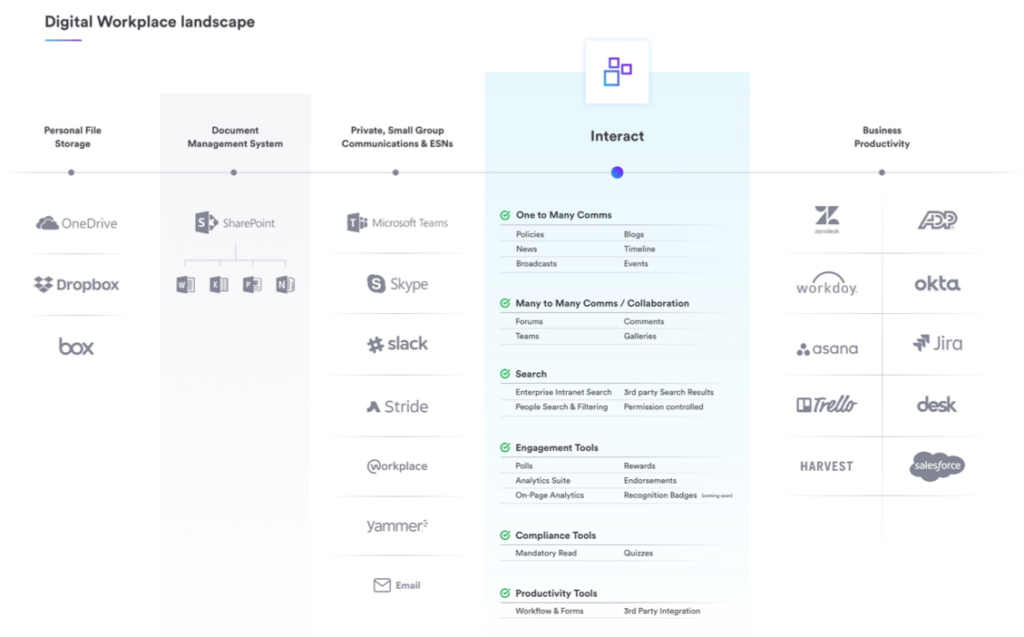Do we need an intranet? 9 questions to ask

If you’re evaluating your digital workplace, considering upgrading your internal communications strategy, or simply curious if an intranet might work for your business, here’s the questions you need to be asking.
“I already have a DMS, Slack, Microsoft Teams and a HR system. Why would I need to add another tool into the mix?”
“We’re all based in one office. If we need to communicate something, we can just hold a meeting or send an email around.”
“We’ve got SharePoint. Isn’t that an intranet?”
“We’re a small business. We have no internal communications function. There’s no budget in the pot.”
These are just some of the objections that tend to come up when considering the need for an intranet. And they’re valid considerations: an intranet is an investment for any organization, both in terms of cost and resource.
However, the returns and advantages of a successful intranet are significant – and extend much further than many of us realize upfront.
To determine if it’s the right move for your organization – and if the returns will justify the cost – there are some key questions you need to ask.
1. Are our staff engaged and satisfied in their roles and with the organization overall?

While not every organization will formally measure employee engagement as standard, it’s now recognized as a critical link to overall business success.
Whether you use employee net promoter scoring (eNPS), distribute the Gallup Q12, have an annual employee survey, send out pulse surveys or simply hear the staff water cooler talk, the chances are, you’ll have a rough idea of how your staff are feeling overall. Employee disengagement can be hugely costly to an organization.
Gallup found that an actively disengaged employee costs their organization $3,400 for every $10,000 of salary, or 34 percent.
Admittedly an intranet isn’t a silver bullet to cure your engagement levels. However, underpinned by a clear strategy and objectives, it can build and support an engaged workforce – whether by giving them a voice, improving visibility of leadership and business direction, connecting them to peers, and more.
2. Can our employees access the right information, when and where they need it?
In today’s knowledge economy, information management is critical. However, too many organizations are continuing to battle scattered shared drives, multiple versions of essential documents stashed on desktops, or the company SharePoint that has exploded on such an atomic scale that no-one knows where to look anymore.
Ensuring staff can access the right information, confident it is current and correct, regardless of their location or device, isn’t a nice-to-have. It’s critical. Whether it’s essential policies and procedures or the ability to find answers to a FAQ from a customer, it can directly impact on compliance, safety procedures, customer experience, and more.
A centralized intranet CMS and integration with your cloud-based storage, underpinned by a powerful enterprise search, gives staff everything they need. With an intranet mobile app, that’s also information they can get on-the-go.
3. Do our current tools or platforms meet our internal communication – and user – needs?
We have increasingly diverse digital workplaces and thanks to the growing BYOD and BYOA culture, we’re almost overrun with different options.
But even if you’re juggling email and OneDrive, Slack and SharePoint, Skype, Yammer, Zendesk, Workday, Asana and more, this doesn’t necessarily mean you’re meeting the needs of your employees.
In evaluating the digital workplace, we find applications typically fall into four categories: personal file storage, document management, private, small group communications and enterprise social networks, and business productivity tools. Actually, none of these satisfy the need for business-wide communication or establishing a common virtual culture.

Today’s intranet platforms are designed to fill those gaps and answer the increasing demand for a better digital employee experience (DEX): providing a gateway for the digital workplace by connecting with other tools, while focusing on the value and importance of user experience. They facilitate two-way conversations on a wider scale and support the strategic objectives of the organization.
4. Do staff understand – and believe in – who we are, what we do, our mission and values?

In today’s workplace, many staff want to work for more than just a paycheck. They’re seeking a sense of connection and feeling of purpose in their work. Those who feel they’re working with a sense of purpose are shown to be more motivated, productive, demonstrate higher levels of morale, longer tenure and greater overall job satisfaction.
49% of employees would trade a portion of their salary to continue in their current role with an added sense of purpose.
Your company values shouldn’t be hidden away in the new starter introduction email, or simply pasted on the office wall and forgotten about. They should be an embedded and living part of your organizational culture.
If you have remotely based staff in particular, an intranet can play a huge role here: in not only making those values front-and-center, but giving staff visibility of business achievements, integrating your values as part of formal recognition programs, aligning staff contributions to the big picture, creating a sharing culture, and more.
5. Do we have a strong employer brand?
Attracting and retaining top talent can be a tall order, as average tenure continues to decline, and organizations are increasingly placed under the spotlight in a world of employee reviews and social media. Employer brand has risen onto the management agenda in response.
Organizations that prioritise employer brand are 250% more likely to rate their overall talent acquisition efforts as highly effective (Glassdoor), see a 54% increase in the quality of candidates applying, and a 43% decrease in cost per hire.
67% of jobseekers also say they’d accept a lower salary if the company had exceptionally positive reviews online.
Establishing and communicating a strong employer brand is no longer solely in the hands of HR. It’s something that comes from the inside-out. Employee advocacy is a powerful differentiator and helps communicate to the outside world what your organization is like to work for.

An intranet not only enables us to communicate values, mission and purpose. It creates a shared digital space where staff can connect, collaborate, share and celebrate success, receive and give recognition, access training or development opportunities, tap into our CSR efforts, understand our benefits, observe our internal brand, connect with leadership and more. All of these help establish and communicate our brand as an employer: and build buy-in among staff.
6. Do our staff know who their leaders are?
Who’s the boss?
If you’re a dispersed or large organization, the chances are, many of your frontline or grass-roots staff will never have met those at the top.
However, leadership is cited as one of the increasingly important components of employee engagement, according to Gallup. Hearing from the boss also makes a difference to how staff define purpose in their work, perceive the culture of the organization, and commit to the pursuit of common goals.
But unless your CEO is able to personally visit every store, kiosk, factory or remote worker, you need to find another way to get leaders more visible to employees. An intranet can be used to give senior leaders a platform that reaches across the business: whether that’s to deliver business updates, give recognition, communicate change and more.
7. Are our staff as productive and efficient as they should be?

Are your staff manually filling in paper-based expenses claims or forms? Is your HR function fielding the same questions from different staff members day in, day out? Or perhaps your IT team is wasting time resetting forgotten passwords, explaining how to use certain tools, or dealing with duplicated staff tickets?
The average member of staff spends 8hours a week searching and gathering information. Improve that by just 5% and for a 5,000 strong workforce, you save 2,000 working hours a week.
Centralizing your common business workflows and processes, FAQs and ‘how to’ guides, or configuring your intranet as an identity provider – meaning staff only have to remember one password to access all their different platforms – can significantly chip away at the time wasted in your business.
Ensuring you have a single source of truth and centralized access to all your knowledge and information, along with rich profiles in a searchable People Directory, all ensure staff can access the people, tools and information quickly and efficiently. An intranet is the center and focal point of your business: and supports staff to do their jobs.
8. Are we delivering a positive customer experience?
The relationship between happy customers and happy employees is clear. In a competitive market where the customer experience can be the sole differentiator for a brand – and one simple Twitter rant can bring down a brand overnight – ensuring your staff are well-equipped to deliver outstanding service is critical.
Generally, when customers have a positive experience with a business, it’s because the employee responsible is happy and willing to go the extra mile. This comes down to a multitude of factors, some of which we’ve already mentioned – access to the information needed to answer and field customer enquiries, for example; the ability to connect with colleagues who can help where needed, or an understanding of what your organization’s mission and what it stands for.
An intranet can also host and standardise processes, improving consistency across your brand, or be used to facilitate a centralized training program that ensures every individual is delivering the same experience for your customers. It can improve employee engagement and overall staff satisfaction, which translates through to the experience staff deliver externally.
9. Can we reach our staff and give them the information they need in an emergency or crisis situation?

A crisis, whether internally-based or external, can escalate rapidly in today’s social media-driven world. Ensuring your staff are safe and have all the information they need to respond is crucial.
However, that’s a process that comes with challenges: particularly if you have staff out on the road, on the frontline, on the shop floor.
An intranet can be set up to serve as a crisis communication system, distributing urgent, point-in-time information across multiple channels to alert individuals of crisis, confirm safety, and provide critical information. This includes distributing alerts via SMS – 90% of SMS messages are read within 3 minutes – via a push notification, email, intranet homepage blocker, and banner.
You can also house emergency protocols and procedures; create and coordinate a crisis management team across the boundaries of timezone or location, and even establish an employee toolkit to support staff.
Investing in an intranet: can you afford not to?
It’s a long-term commitment to find the right solution or provider, to get a business case together, to take on the build and launch process. It takes time to maintain and evolve your intranet, to ensure it delivers on your original objectives and remains relevant for your business. It’s understandable when senior leaders are hesitant to buy-in to the idea.
However, when weighing up the pros and cons, it may be a question of whether you can afford not to.
If you find yourself answering ‘no’ to even one or two of the questions above, it’s likely an intranet will more than deliver a return on investment and play a critical role in transforming how your organization operates.
However, perhaps the best way to determine if an intranet will have value is to ask those who stand to benefit. Speaking with your staff can throw up business challenges or niggles you never even knew existed – and ones that a successful intranet could solve, to the long-term benefit of your organization.
